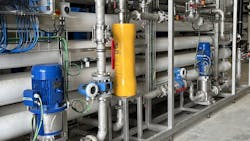Harnessing reverse osmosis energy for more efficient water reuse
Key Highlights
- Energy recovery devices capture hydraulic energy from concentrate streams to reduce the workload of high-pressure pumps in RO systems.
- Projects in Belgium and China show that ERDs can cut energy use by up to 30%, delivering quick financial payback and environmental benefits.
- Retrofitting existing RO plants with ERDs is feasible and can be done with minimal downtime, providing immediate operational savings.
As energy costs climb and sustainability requirements grow more stringent, water utilities and industrial operators are reassessing how to improve the energy performance of their water treatment infrastructure. Among the processes under scrutiny, reverse osmosis (RO) systems represent one of the largest energy consumers in both water reuse and brackish desalination facilities.
Energy recovery devices (ERDs) like pressure exchangers, long established in seawater desalination, are now being adapted and deployed in lower-pressure RO applications, such as water reuse and brackish water treatment. Advances in design and materials have made ERDs viable at moderate pressures, where they can recover hydraulic energy from the concentrate stream and transfer it to the feedwater. This reduces the duty of high-pressure pumps and significantly lowers overall power consumption.
Two recent projects, a municipal water reuse facility in Belgium and an industrial reuse plant in northern China, demonstrate how integrating energy recovery into RO design can yield tangible operational and environmental benefits.
Reducing RO energy demand in water reuse systems
RO systems for water reuse and brackish desalination typically operate at pressures between 6 and 20 bar (90–290 psi), depending on salinity and recovery targets.
ERDs help reduce RO energy consumption by transferring hydraulic energy from the pressurized concentrate (brine) stream to the low-pressure feed stream. This recovered energy reduces the net work required by the RO high-pressure pump, leading to savings in both power consumption and operating cost.
Because electricity prices in many regions have increased sharply over the past several years, technologies that reduce energy intensity are gaining renewed attention. When properly selected and configured, ERDs can make a measurable difference, especially in regions where water scarcity is driving large-scale reuse investment.
Municipal reuse facility in Belgium
In the Flanders region of Belgium, the Flemish Environment Agency (VMM) launched several projects under the Blue Deal initiative, an ambitious program designed to address drought and water scarcity through efficiency and reuse. One of the first of these, the Water Production Center Hofstade (WPC) project in Aalst, was commissioned in 2025 as a municipal-scale demonstration of multi-barrier direct potable water reuse.
The facility integrates a multi-barrier train including ultrafiltration, reverse osmosis, activated carbon, ultraviolet disinfection, and free chlorine, like potable reuse systems used in California, Singapore, and Australia. The RO stage operates at about 75% recovery, with feed pressures between 6.7 and 13.9 bar (100–200 psi), producing roughly 54 cubic meters per hour of permeate and 18 cubic meters per hour of concentrate.
To improve energy efficiency, an ERD specially designed for low-pressure applications manufactured by Energy Recovery, was incorporated to capture pressure energy from the concentrate stream and redirect it into the feedwater line. This reduced the RO plant’s total energy consumption by 23%. The system was designed for flexibility across temperature, feedwater, and recovery variations, allowing stable performance throughout the year.
The investment achieved an estimated payback period of around three years, demonstrating that energy recovery can be economically viable even at the lower pressures typical of municipal reuse facilities.
Industrial wastewater reuse in China
In Tangshan, a major industrial center in Hebei Province, China, water scarcity has intensified due to expanding steel and chemical production. The city’s wastewater reuse plant, operated by a public utility, has become an essential part of regional water management.
When the facility expanded its RO capacity to meet rising demand, energy consumption rose sharply. The additional RO pumping requirements conflicted with the country’s broader carbon-reduction goals and placed financial pressure on plant operations. To address this, the utility opted to retrofit part of the RO system with low-pressure ERDs from Energy Recovery to recover energy from the brine discharge and reduce the high-pressure pump duty.
At approximately 70% recovery, each RO train discharged about 80 cubic meters per hour of high-pressure concentrate. The recovered pressure energy was used to pressurize incoming feedwater, allowing the main pump to handle only the permeate flow. This retrofit achieved a 25% reduction in the RO pump power draw and corresponding energy savings in the retrofitted train, with minimal downtime during installation.
Operational data showed consistent energy performance and stable automation control. Specific energy consumption (SEC) improved from ~1.03 to ~0.77 kWh/m³, with estimated annual energy savings of ~394,200 kWh (~$27,600 at $0.07/kWh) and ~265 t CO₂ avoided. The project demonstrated that ERDs can be integrated into existing industrial reuse systems without disrupting process reliability, a critical factor for facilities with continuous operation requirements.
Lessons for broader application
Both examples illustrate that energy recovery is not limited to high-pressure seawater desalination. In lower-pressure reuse and brackish water RO applications, ERDs can provide measurable efficiency gains and fast financial returns. The scale of benefit depends on system pressure, recovery ratio, and operating hours, but in many cases, specific energy savings of up to 30% are achievable.
As electricity costs continue to rise and carbon-intensity metrics become embedded in water-sector reporting, energy recovery is emerging as a standard in RO design. Beyond the direct financial savings, reducing power demand in water treatment has broader implications for sustainability and grid resilience.
For utilities and industrial operators, incorporating ERDs during RO plant design, or as part of retrofit programs, offers a straightforward way to reduce lifecycle operating costs and environmental impact. In the long term, such measures support more sustainable water management and contribute to the circular economy goals many regions are now pursuing.
About the Author

William Harvey
William Harvey is the Director of Global Business Development, Wastewater for Energy Recovery. From start-ups to large multinationals, he often leads global teams to solve problems in water scarcity and food production verticals, especially as they intersect with energy space. He began his career in 1988 at Ionics, Inc. working on the wastewater treatment plant design of the first zero liquid discharge (ZLD) power plant in New England. His interests are in monetizing novel and IP-rich technologies on a global basis.

